

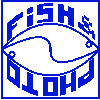
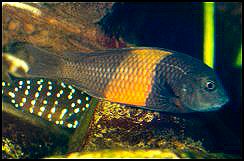
![]() .Tropheus
moorii Chipimbe.
.Tropheus
moorii Chipimbe.
![]() Tropheus
duboisi.Maswa
Tropheus
duboisi.Maswa
![]() Tropheus
moorii rainbow
Tropheus
moorii rainbow
Tropheus moorii keizer![]()
Tropheus duboisi![]()
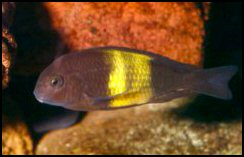
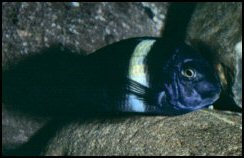
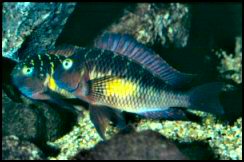
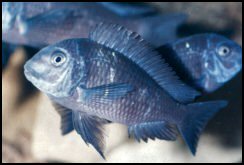
   | ||
| | ||
 |
|
|
|
|
|
|
|
Tropheus
polli (G.S.Axelrod,1977) Tropheus polli is one of the seldom Tropheus-types with in mature state a kind of a pattern with stripes. With the other specimen the striping pattern is characteristic for the juveniles. Farther characteristics are the special pattern of stripes and the form of the fins. The tailfin shows resemblance with a swallow's tail. Tropheus polli is a little bit larger than the other specimen;ca. 16,5 cm is quite normal for a mature man. Grown up man are solid gray or brown, with some olive-green reflections. The body and the fins of the female and the juveniles are olive-green green or brownish and on the sides there are eight white-yellow diagonal bars between the gill covers and the root. A nineteenth bar is on the outer part of the gill covers. You often see also stripes on the snout and above eyes. The last one mostly runs across the jaws until the throat. The eyes are light blue with a black upper edge. On the gill covers there is a black spot. In the soft part of the dorsal and anal fin and in the tailfin too there are little spots and orange stripes. Before this species was known at the name the "Wimpelmoorii". On the determination the electronic microscope was used to examine the teeth in detail and a description sometimes is illustrated with remarkable pictures of it. G.S. Axelrod declares that the colors are no criterion after all there exist several colorvariants of the specimen. Others on the other hand estimate the colors and also the place of the colors of great importance at the ascription just like the place where they were caught can play a role. In this way the dominant red color Characteristic for the southern variants of Tropheus moorii. Possible the electronicmicroscopes-can-method give interesting insights. I assume that for the moment we have a useful classification; however the last word about that certainly is spoken not yet. All the more because of a number of splendid specimen, under thereunder f.e. the striking Tropheus "Bulu Point" are still waiting for an official description. Tropheus polli occurs in the littoral zone at a depth from 6 until tot 10 meters in the mid of the Eastern coast apposite of the Lukuga river and Kalemi. It seems to be that also along the Southern coast of Bulu Island and around Bulu Point there haunt a population. |
Purchase: |